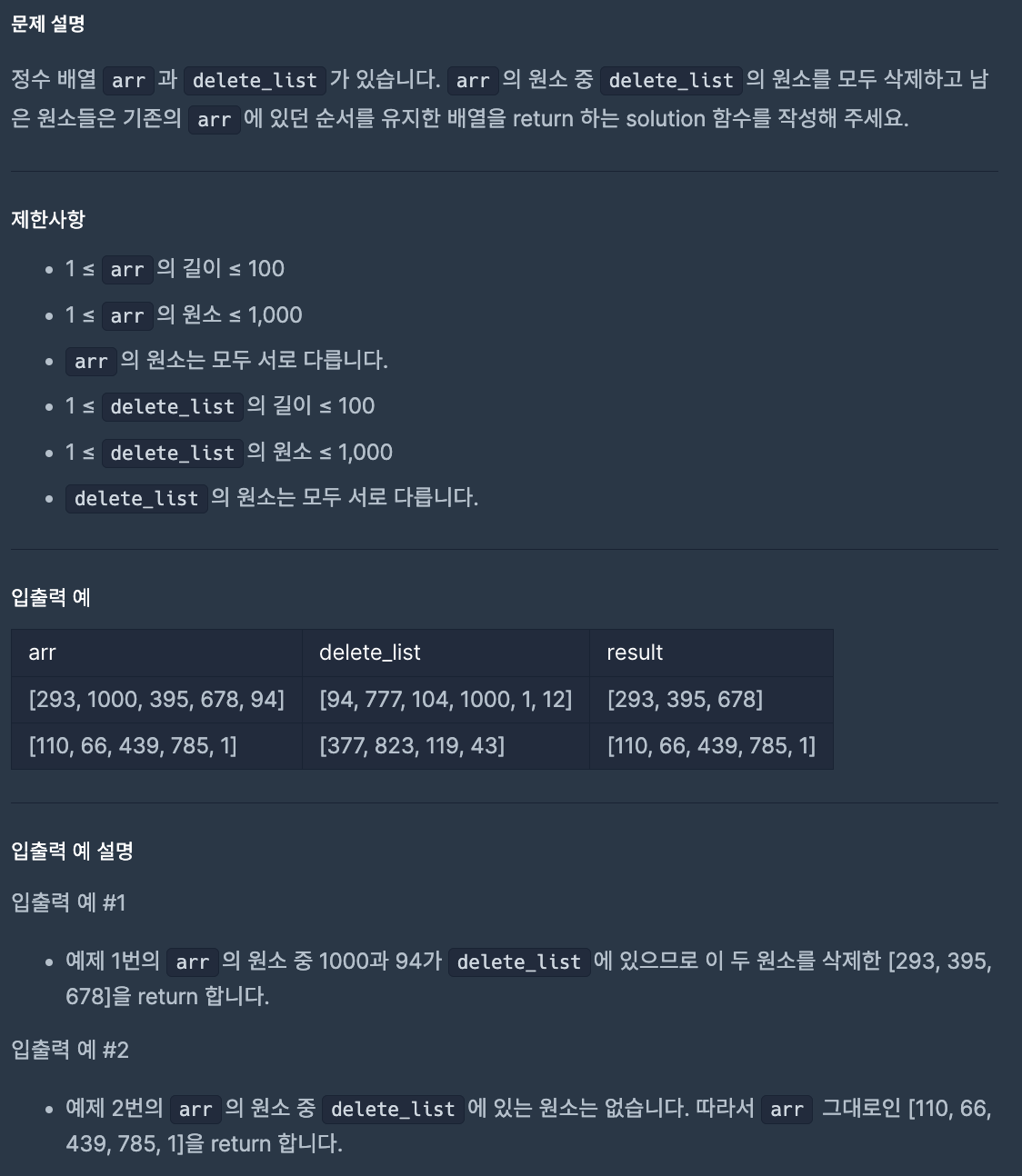배열의 원소 삭제하기
https://school.programmers.co.kr/learn/courses/30/lessons/181844
- 문제 풀이
1
2
3
4
5
6
7
8
9
10
11
12
13
14
15
16
17
18
19
20
21
22
23
24
25
26
27
28
29
30
31
32
33
import java.util.ArrayList;
import java.util.HashSet;
import java.util.List;
import java.util.Set;
public class Solution {
public List<Integer> solution(int[] arr, int[] delete_list) {
// 삭제할 원소들을 Set에 저장한다.
Set<Integer> deleteSet = new HashSet<>();
for (int num : delete_list) {
deleteSet.add(num);
}
// 삭제할 원소가 아닌 원소들을 저장할 리스트를 생성한다.
List<Integer> result = new ArrayList<>();
for (int num : arr) {
if (!deleteSet.contains(num)) {
result.add(num);
}
}
return result;
}
public static void main(String[] args) {
Solution sol = new Solution();
List<Integer> result1 = sol.solution(new int[]{293, 1000, 395, 678, 94}, new int[]{94, 777, 104, 1000, 1, 12});
System.out.println(result1); // 출력: [293, 395, 678]
List<Integer> result2 = sol.solution(new int[]{110, 66, 439, 785, 1}, new int[]{377, 823, 119, 43});
System.out.println(result2); // 출력: [110, 66, 439, 785, 1]
}
}
1
2
3
4
5
6
7
8
9
10
11
12
13
14
15
16
17
18
19
20
21
22
23
24
25
26
27
28
import java.util.ArrayList;
import java.util.List;
public class Solution {
public int[] solution(int[] arr, int[] delete_list) {
List<Integer> list = new ArrayList<>();
// 배열을 리스트로 변환
for (int num : arr) {
list.add(num);
}
// delete_list의 원소를 리스트에서 제거
for (int num : delete_list) {
while (list.contains(num)) {
list.remove(Integer.valueOf(num)); // Integer 객체로 변환하여 삭제
}
}
// 리스트를 배열로 변환하여 반환
int[] result = new int[list.size()];
for (int i = 0; i < list.size(); i++) {
result[i] = list.get(i);
}
return result;
}
}
- Set을 사용한 이유는 다음과 같다:
- 중복된 원소를 방지하기 위함: Set은 중복된 원소를 허용하지 않으므로,
delete_list에 중복된 원소가 있더라도 Set에 저장할 때 중복이 제거된다. - 빠른 탐색을 위함: Set은 해시 테이블을 사용하여 원소에 대한 빠른 탐색을 제공한다. 따라서
delete_list에 포함된 원소를 효율적으로 확인할 수 있다. - 삭제 여부 확인을 위함:
delete_list에 포함된 원소인지를 확인하기 위해 Set의contains메서드를 사용하면 O(1)의 시간 복잡도로 확인할 수 있다. 따라서 더 효율적인 알고리즘을 구현할 수 있다.
- 중복된 원소를 방지하기 위함: Set은 중복된 원소를 허용하지 않으므로,
이 기사는 저작권자의 CC BY 4.0 라이센스를 따릅니다.
